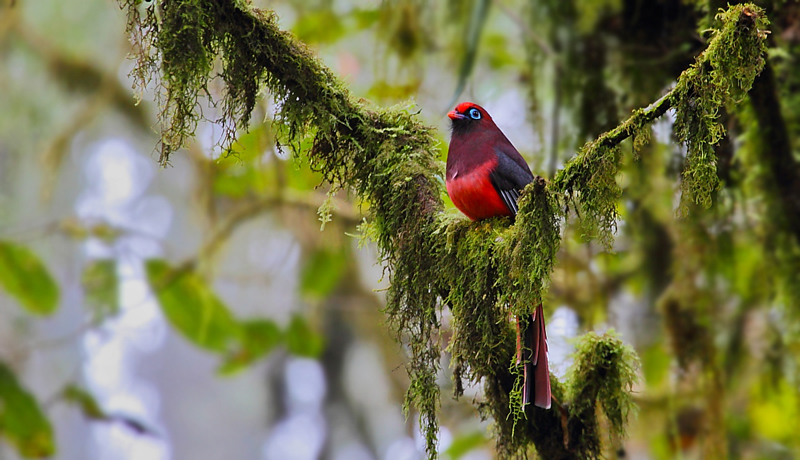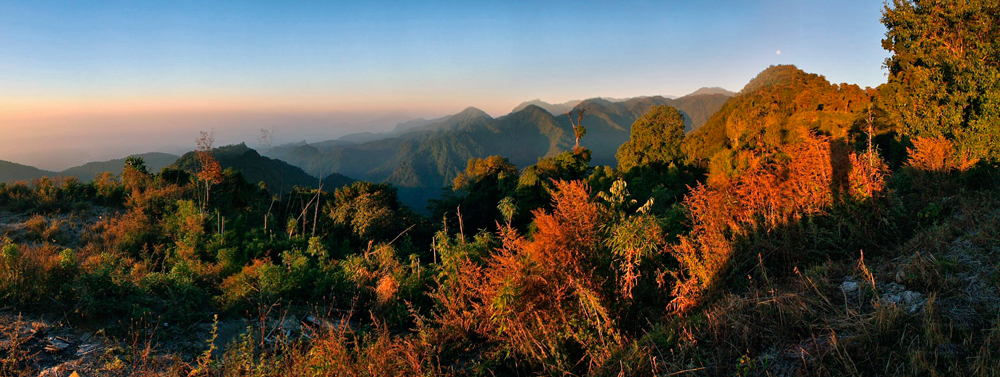Area 217 sq. km.
Altitudinal range 500 – 3300 m ASL
Latitude 27º 02′ – 27º 09′ N | Longitude 92º 18′ – 92º 35′ E
Monsoon June to September
Best time to visit October to May
Timeline
Doimara Reserve Forest in 1966
Wildlife Sanctuary in 1989
Kameng Elephant Reserve in 2002

Abies stands on the way to Pirila pass. Photo credits: Rohan Pandit
Eaglenest Wildlife Sanctuary, in the West Kameng district of western Arunachal Pradesh, is a bio-diversity paradise. Eaglenest is the centrepiece of the Kameng Protected Area Complex, 3,500 sq. km. of mostly contiguous forests spread across two states and five protected areas.
VEGETATION Eaglenest has a wide range of forest types – from tropical evergreen forests in the lower elevations, to temperate broad-leaved forests in the mid altitudes, to conifers and rhododendrons at the highest elevations. Most parts of Eaglenest have extensive bamboo cover. Eaglenest is one of the last strong-holds for species such as the Asian yew (Taxus wallichiana) and the Anise tree (Illicium griffithi). The critically endangered Gymnocladus assamicus which is endemic to north-eastern India, is also found here.
BIRDS The spectacular bird diversity of Eaglenest and its surrounding forests has been the keystone in ensuring its protection by the resident Bugun and Shertukpen communities. Over 700 species of birds are known from a 100 sq. km. region centered around Eaglenest – second in the world only to the eastern slope of the Andes in South America. The most important discovery remains that of the Bugun Liocichla (Liocichla bugunorum), found nowhere else in the world, but only on a one sq. km. patch of forest on Bugun community land. Other spectacular and rare bird species include Ward’s Trogon (Harpactes wardii), Beautiful Nuthatch (Sitta formosa), and Wedge-billed Babbler (Sphenocichla humei).

Ward’s trogon at Eaglenest. Photo credit: James Eaton
MAMMALS Commonly sighted mammals include elephant, wild dog, serow, capped langur and gaur. The recently discovered Arunachal macaque is also found in Eaglenest, as are the rare spotted linsang, red panda, slow loris, clouded leopard and golden cat.
SNAKES About 32 snake species have been recorded till date. Highlights include the rediscovery of the Darjeeling false wolf snake (Dinodon gammiei) after a gap of 80 years. Ten snake species recorded from here had never been photographed in India before research began in Eaglenest.
AMPHIBIANS & LIZARDS Twelve species of lizards and 35 species of frog have been recorded till date, but several more certainly await discovery. The lizard Mictopholis austeniana was rediscovered in Eaglenest after 130 years, whereas frogs of the genus Occidozyga and Theloderma have been rediscovered after over a century. The Bongpu Litter Frog (Leptobrachium bompu), a species new to science, was discovered in Eaglenest in 2009.
BUTTERFLIES Of the 1,250 species recorded in India, 250 species have been reported from Eaglenest, with many more still waiting to be revealed. Eaglenest is one of the best locations to see one of India’s prettiest butterfly – the Bhutan Glory (Bhutanitis lidderdalei). A week’s visit will result in at least a 100 species of butterflies. The best months to see butterflies are April-June and September-October.
MOTHS Of the 10,000 moth species estimated to exist in India, more than 400 species have currently been identified in Eaglenest. An equal number are yet to be identified! Eaglenest is likely to be home to more than 1,000 moth species. A moth screen on a moonless night in the right season can attract up to 3,000 moths!
COMMUNITY-BASED ECO-TOURISM The bird and wildlife based eco-tourism in Eaglenest and the adjoining community forest is a unique conservation initiative that is entirely community owned and and run. It is one of the few successful community-based eco-tourism programs in the entire country, where conservation of wild habitats and economic development of resident communities go hand-in-hand.
GETTING THERE
NEAREST TOWN Tenga (17 km. from Lama Camp, and 40 km. from Bongpu). Luxury hotel rooms are available at Tenga.
NEAREST AIRPORT Tezpur (110 km.). However, flights to Tezpur are only on a couple of days a week, whereas there are several flights to Guwahati airport (300 km.) everyday. Driving time from Guwahati to Tezpur is 4 hours, and driving time from Tezpur to Tenga is 5 hours. There are regular buses and shared taxis plying from Guwahati and Tezpur. Shared taxis for Tenga are available from the Assam State Transport Corporation bus stand in Tezpur in the morning, and in the afternoon. A vehicle needs to be hired to go from Tenga into Eaglenest Wildlife Sanctuary.
Note: Permission from the Forest Department is required to visit and stay inside Eaglenest.
WHERE TO STAY
LAMA CAMP Situated in Bugun community forest land at an elevation of 2500 m ASL, this is a permanent campsite offering tented accommodation. On clear days, visitors can get spectacular views of the snow-capped Gori Chen range in Tibet from the dining room. The newly discovered bird species, the Bugun Liocichla, is found around Lama Camp.
BONGPU This campsite, also offering tented accommodation, is situated within Eaglenest Wildlife Sanctuary, at an elevation of 1900 m ASL in the midst of montane wet temperate forest. The lower elevations of Eaglenest (Sessni, Khellong) can be accessed from this campsite. Specialties around Bongpu are the newly discovered Bongpu Litter Frog, Blyth’s Tragopan, Wedge-billed Babbler and Slender-billed Scimitar Babbler.
RAMALINGAM is in community forest about 8 km. away from Tenga. It has a Forest Rest House and a tourist camp. Ramalingam is a good place to look for animals of open habitats which are difficult to see inside the sanctuary.

Fire-breasted flower pecker at Eaglenest. Photo credit: Rohan Pandit
Visit Eaglenest…
The cradle of the world’s biodiversity

